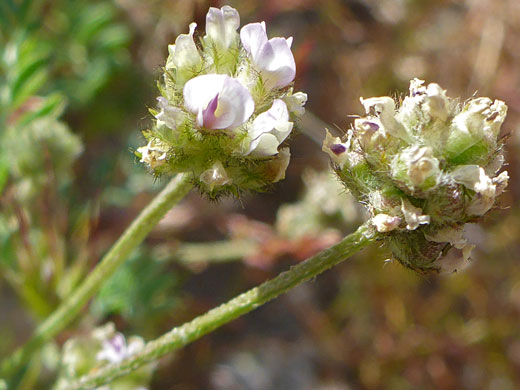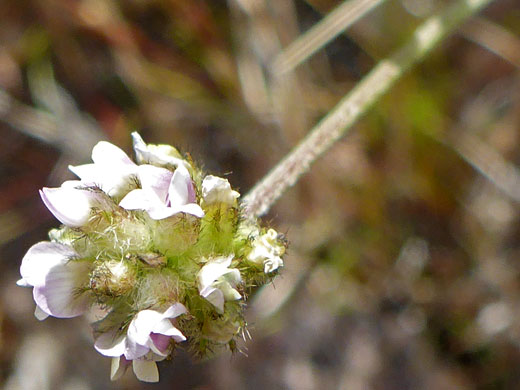Astragalus Didymocarpus, Two-Seeded Milkvetch
Plants > Wildflowers > Fabaceae > Astragalus Didymocarpus
Common names:
Two-seeded milkvetch, dwarf white milkvetch
Family:
Scientific name:
Astragalus didymocarpus
Main flower color:
Range:
South and central California, south Nevada and west Arizona
Height:
Up to 17 inches
Habitat:
Grassland, sandy places, chaparral; up to 4,500 feet
Leaves:
Up to 3 inches long; pinnately divided into between 9 and 17 leaflets, notched at the tips
Season:
February to May
Astragalus didymocarpus is an inconspicuous, small-flowered species, though quite easy to identify; the inflorescence is a dense, compact, egg-shaped cluster, of up to 30 flowers, white or tinged purple, the calyces with a dense covering of straggly hairs, black and white.
The slender, grayish-green stems have a covering of short, strigose hairs; stems may be upright, or close to the ground. Leaves are divided into linear to oblanceolate leaflets, around half an inch long, sparsely hairy along the margins. Fruits are small, two-chambered pods.
Four varieties of astragalus didymocarpus are recognized (didymocarpus, dispermus, milesianus, obispoensis), differentiated by the length and shape of the keel petal, and the relative proportions of the white/black calyx hairs.
The slender, grayish-green stems have a covering of short, strigose hairs; stems may be upright, or close to the ground. Leaves are divided into linear to oblanceolate leaflets, around half an inch long, sparsely hairy along the margins. Fruits are small, two-chambered pods.
Four varieties of astragalus didymocarpus are recognized (didymocarpus, dispermus, milesianus, obispoensis), differentiated by the length and shape of the keel petal, and the relative proportions of the white/black calyx hairs.
All Contents © Copyright The American Southwest | Comments and Questions | Contribute | Site Map



